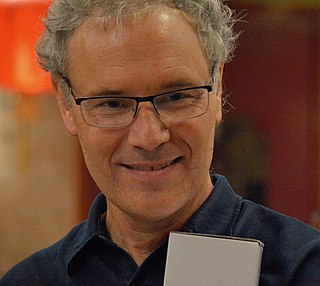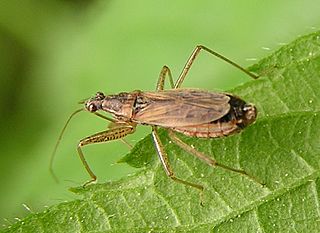
Caenorhabditis elegans is a free-living transparent nematode about 1 mm in length that lives in temperate soil environments. It is the type species of its genus. The name is a blend of the Greek caeno- (recent), rhabditis (rod-like) and Latin elegans (elegant). In 1900, Maupas initially named it Rhabditides elegans. Osche placed it in the subgenus Caenorhabditis in 1952, and in 1955, Dougherty raised Caenorhabditis to the status of genus.

Howard Robert Horvitz ForMemRS NAS AAA&S APS NAM is an American biologist best known for his research on the nematode worm Caenorhabditis elegans, for which he was awarded the 2002 Nobel Prize in Physiology or Medicine, together with Sydney Brenner and John E. Sulston, whose "seminal discoveries concerning the genetic regulation of organ development and programmed cell death" were "important for medical research and have shed new light on the pathogenesis of many diseases".

Sir John Edward Sulston was a British biologist and academic who won the Nobel Prize in Physiology or Medicine for his work on the cell lineage and genome of the worm Caenorhabditis elegans in 2002 with his colleagues Sydney Brenner and Robert Horvitz at the MRC Laboratory of Molecular Biology. He was a leader in human genome research and Chair of the Institute for Science, Ethics and Innovation at the University of Manchester. Sulston was in favour of science in the public interest, such as free public access of scientific information and against the patenting of genes and the privatisation of genetic technologies.

The spermatheca, also called receptaculum seminis, is an organ of the female reproductive tract in insects, e.g. ants, bees, some molluscs, oligochaeta worms and certain other invertebrates and vertebrates. Its purpose is to receive and store sperm from the male or, in the case of hermaphrodites, the male component of the body. Spermathecae can sometimes be the site of fertilisation when the oocytes are sufficiently developed.

The Miridae are a large and diverse insect family at one time known by the taxonomic synonym Capsidae. Species in the family may be referred to as capsid bugs or "mirid bugs". Common names include plant bugs, leaf bugs, and grass bugs. It is the largest family of true bugs belonging to the suborder Heteroptera; it includes over 10,000 known species, and new ones are being described constantly. Most widely known mirids are species that are notorious agricultural pests that pierce plant tissues, feed on the sap, and sometimes transmit viral plant diseases. Some species however, are predatory.

The elegant water shrew is a species of mammal in the subfamily Soricinae of the family Soricidae. It is the only species within the genus Nectogale. It lives in Sikkim and China.

Most animal testing involves invertebrates, especially Drosophila melanogaster, a fruit fly, and Caenorhabditis elegans, a nematode. These animals offer scientists many advantages over vertebrates, including their short life cycle, simple anatomy and the ease with which large numbers of individuals may be studied. Invertebrates are often cost-effective, as thousands of flies or nematodes can be housed in a single room.

Victor R. Ambros is an American developmental biologist who discovered the first known microRNA (miRNA). He is a professor at the University of Massachusetts Medical School in Worcester, Massachusetts.
Gary Bruce Ruvkun is an American molecular biologist at Massachusetts General Hospital and professor of genetics at Harvard Medical School in Boston. Ruvkun discovered the mechanism by which lin-4, the first microRNA (miRNA) discovered by Victor Ambros, regulates the translation of target messenger RNAs via imperfect base-pairing to those targets, and discovered the second miRNA, let-7, and that it is conserved across animal phylogeny, including in humans. These miRNA discoveries revealed a new world of RNA regulation at an unprecedented small size scale, and the mechanism of that regulation. Ruvkun also discovered many features of insulin-like signaling in the regulation of aging and metabolism. He was elected a Member of the American Philosophical Society in 2019.

Martin Lee Chalfie is an American scientist. He is University Professor at Columbia University. He shared the 2008 Nobel Prize in Chemistry along with Osamu Shimomura and Roger Y. Tsien "for the discovery and development of the green fluorescent protein, GFP". He holds a PhD in neurobiology from Harvard University.

Nabis is a genus of damsel bugs in the family Nabidae.

Stenotus is a genus of plant bugs, containing the following species:

Jinfengopteryginae is a subfamily of bird-like theropod dinosaurs known from the Cretaceous of Eurasia. This group includes relatively few genera, with members discovered in 2005 but the name erected in 2012. Like other troodontids, this group of dinosaurs resided in the Paraves potentially close to the Avialae.

Palaemon elegans sometimes known by the common name rockpool shrimp, is a species of shrimp of the family Palaemonidae. It is native to the eastern North Atlantic, the Baltic, the Mediterranean and the Black Sea, and introduced in the Caspian and Aral seas. It is similar to three other members of the genus Palaemon: Palaemon serratus, Palaemon longirostris and Palaemon adspersus, and has displaced or replaced populations of Palaemon adspersus in some locations. It is considered an invasive species in parts of the United States.

Cymus is a genus of true bugs in the family Cymidae. There are at least 40 described species in Cymus.
Dichrooscytus is a genus of plant bugs in the family Miridae. There are more than 70 described species in Dichrooscytus.

Zonocerus is a genus of grasshoppers (Caelifera) in the family Pyrgomorphidae and the tribe Phymateini. The two species are found in Africa, with Z. elegans found in central, eastern and southern regions, including Madagascar, and Z. variegatus found in western regions. Both species are significant agricultural pests, especially for African smallholder farmers. Both adults and nymphs have relatively bright, aposematic colours, and adults typically are about 3–5 cm (1.2–2.0 in) long.
Criocoris is a genus of plant bugs in the family Miridae. There are about 13 described species in Criocoris.

Americodema is a genus of plant bugs in the family Miridae. There are at least two described species in Americodema.
Teratocoris is a genus of plant bugs in the family Miridae. Species are recorded from the Palaearctic and Nearctic realms.















